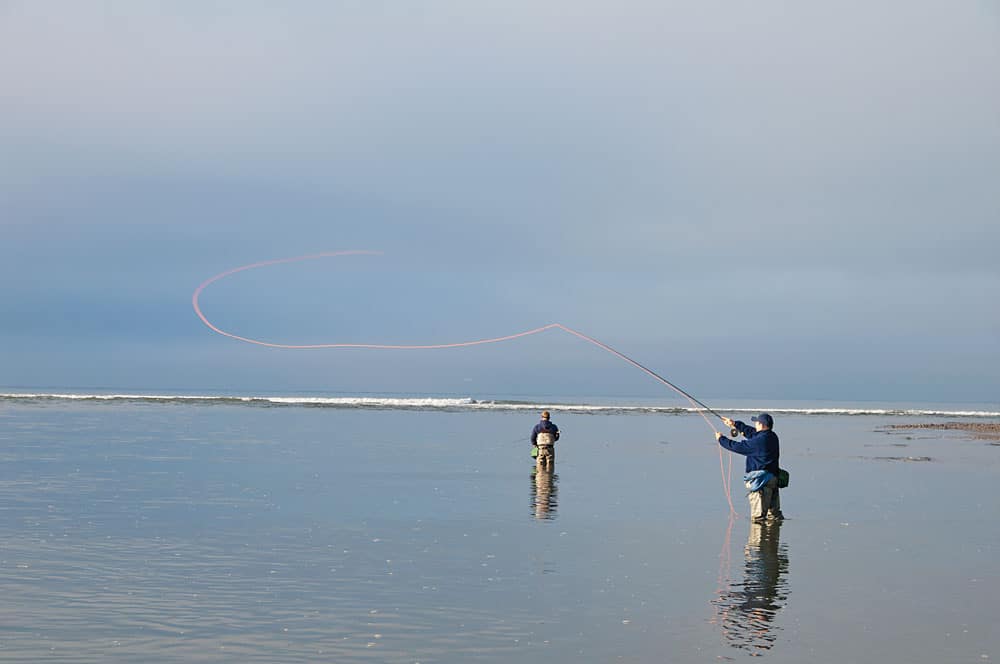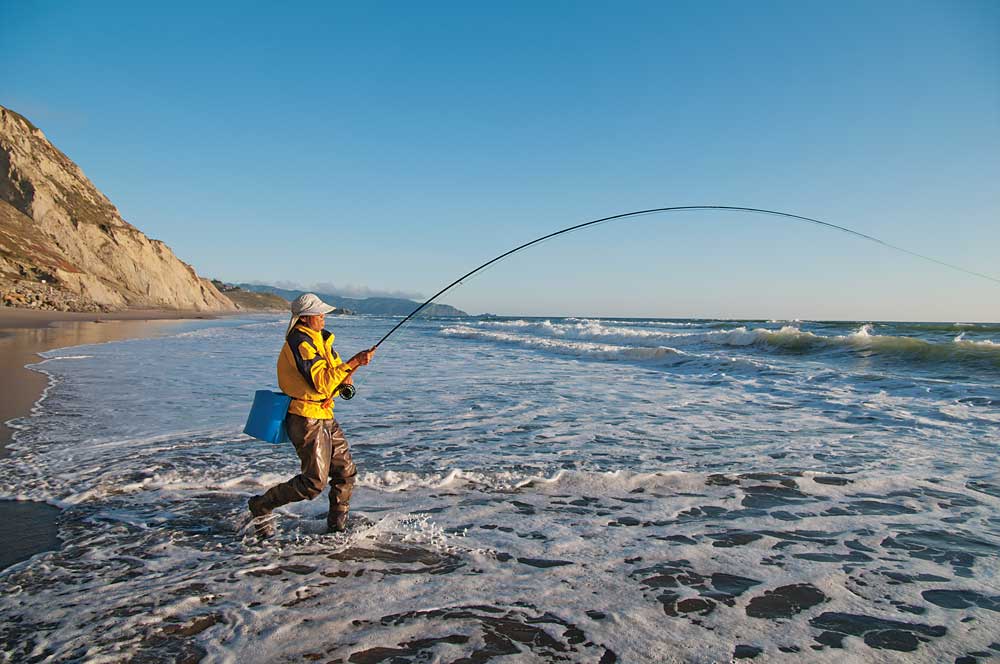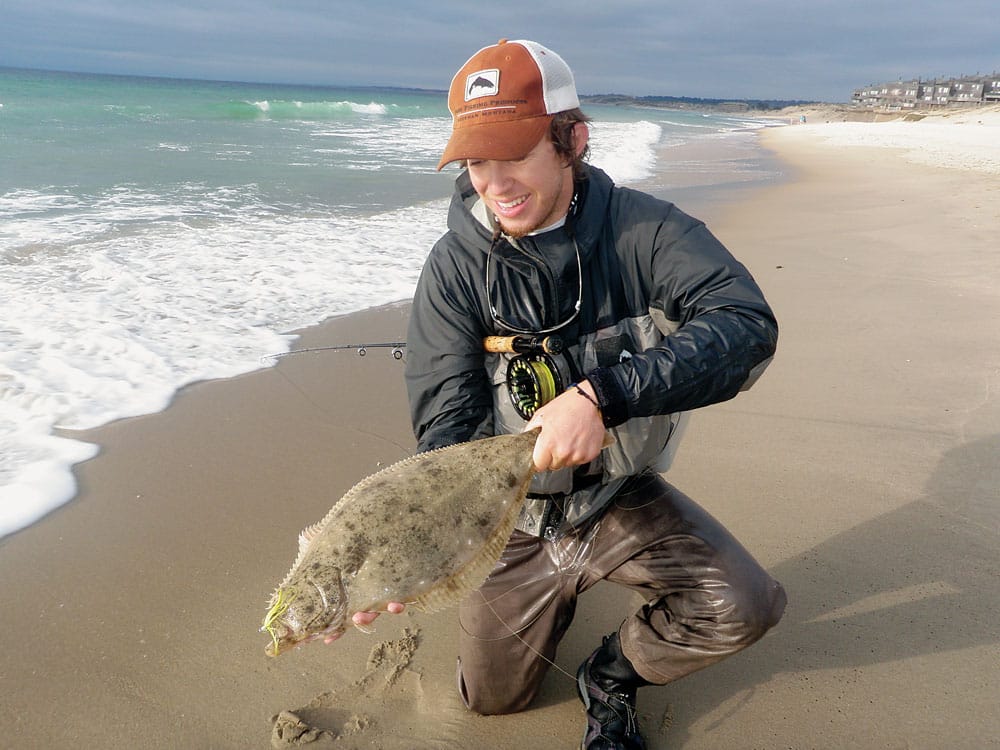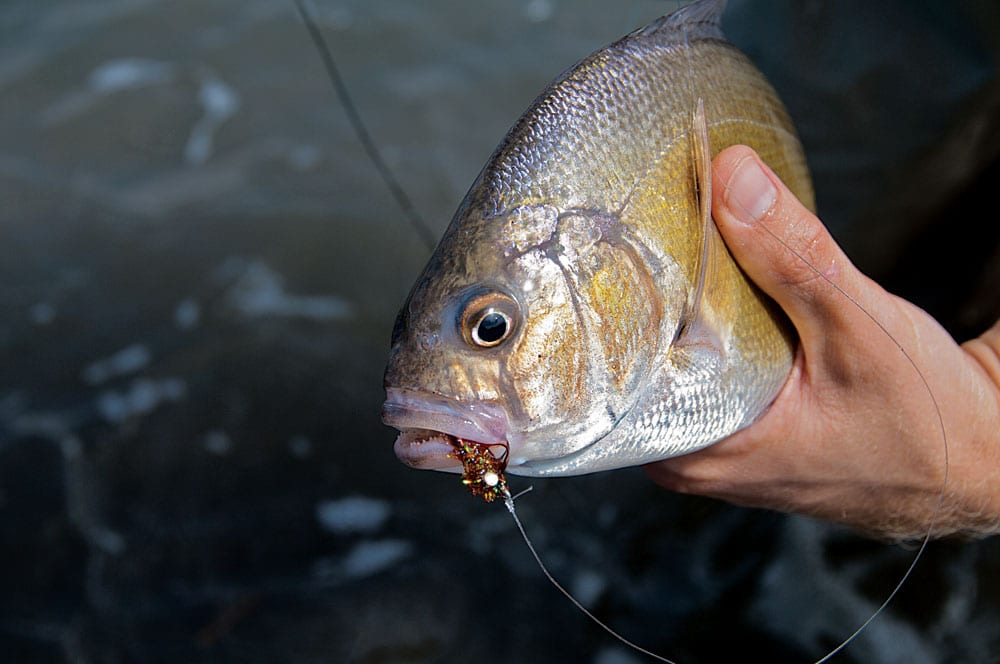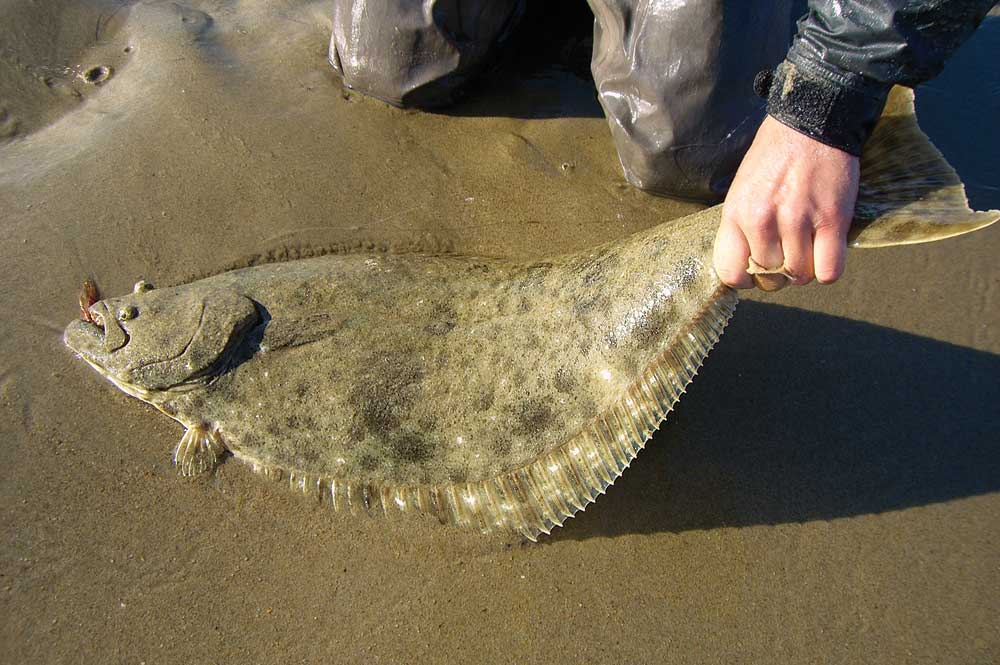
California Halibut
California halibut may not have as much cachet as other fly-rod game fish, but that is certainly not because they shouldn’t. A distinct species from Pacific halibut, their northern brethren which grow to barn-door proportions in the deep waters of Alaska, California ’buts live in shallower waters and grow to more modest sizes. They can be found from the Pacific coast of Mexico’s Baja Peninsula up through northern California. From Monterey Bay south offers the best opportunities for hooking up, but anglers can find fish all the way up to the San Francisco Bay area.
Keys to Success
These halibut have a reputation as deepwater dwellers, and for a reason. The biggest ’buts are usually caught from boats trolling lead balls on the bottom in deep water. However, during certain times of the year, fly-anglers can be very successful in targeting them with the proper techniques. These fish move into the shallows of calmer surf, bays and marinas during the summer months as part of their spawning migration. The farther south you are in their range, the better odds you have of catching them on fly. Halibut are quite a common quarry in the San Diego and Los Angeles areas, while northern California anglers will have to look a little harder to find them. That being said, a perseverant angler will absolutely connect if he puts in the time from May through August, and there are opportunities in the spring and fall too.
Understanding the water that California halibut hold in is the first key to success. You will very rarely find them in rough surf, as they much prefer calmer water. This means that beaches with some protection from the open Pacific swell offer much better fishing than those that get pounded by larger waves. Stretches of sand protected by jetties, breakwaters or penin-sulas are likely hot spots. Beaches that normally are too rough for halibut can produce on low-swell periods, when the inshore zone becomes calm enough for them to move within fly-casting range. Halibut also can be targeted inside bays, harbors and marinas. When searching in these environs, be sure that you are fishing salt water and not brackish water, as these fish are much less tolerant to drops in salinity levels than their relative, the starry flounder. Despite their bottom-orienting nature, halibut actually move quite a bit with the tides. Do not be fooled into thinking that just because you have worked a particular piece of structure well, it is not likely to produce a short while later.
Halibut are ambush feeders. As flatfish, they are equipped with the ultimate camouflage in the marine world. Though they will actively feed high in the water column at certain times (I have even heard numerous accounts of halibut busting the surface while chasing bait), they have a unique primary method of attack. They strategically position themselves for ambushing prey and then tuck themselves into the sand on the bottom, with little but their eyes protruding. In this position, they wait to attack any hapless baitfish or crustacean that might swim overhead. With this in mind, be sure to fish over sandy bottom when pursuing halibut. Though working around rocky structure likely to attract forage is a good idea, it is paramount that the fly is fished over sandy potholes and ledges in the area.
Along the beachfront, success is dependent on locating the pieces of structure that halibut utilize as ambush spots. Once you are keyed in on sandy troughs, buckets and ledges, much of the battle is won. These pieces of structure are usually not too hard to recognize with some practice in reading the surf. The trick to identifying these subsurface contours lies in the foam above them. Calmer and deeper water is given away by a lack of both breaking waves and white foam. The waves and resulting foam are created from the incoming swells breaking when they hit shallow water, usually sandbars. This water tends to be rough, and as a result, halibut will rarely, if ever, hold here. Adjacent deeper water will be apparent because of the green or blue color of its surface, as opposed to the white of the foam, in addition to the absence of regularly cresting waves. You are likely to hit pay dirt if you can locate where a wave-beaten sandbar drops off into a deeper hole or trough, as this is a prime point for halibut to lie in wait. This might be a subtle drop from one to three feet, but that is all it takes at times. Just off the drop-off, fish will protect themselves from strong currents by scooching up to the base of the ledge and letting the faster-moving water shoot overhead. Then they will peer up at the conveyor belt of food, as all types of tasty morsels will be whisked over their heads with the current washing off the sandbar and back into the deeper water of the hole or trough.
An Opportunistic Nature
When you’re searching for these halibut hide-outs, scoping beaches on a minus low tide can help in locating structure even if the area is drained and needs a few more feet of water before fish will move into it. I make note of promising spots with landmarks on the beach, returning to them once they have been flooded in hopes that a few flatties have moved in with the tide. It is vital to make sure these pieces of structure have access to the deeper water outside the surf. A hole or trough close to the beach might look prime, but if it is completely sealed in by a shallow outside sandbar, it is unlikely that fish are going to cross the bar to come within range except for at the top of the tide, when the inside structure will be out of casting range anyway.
Because of the wait-and-attack method in which halibut feed, a jiggy presentation near the bottom is most effective. For the most vertical presentation possible while retrieving the fly, I keep my strips short and abrupt. This pops a dumbbell-eye fly off the sand and then gives it time to nose-dive back toward the bottom, maximizing the action of the fly while keeping it in the feeding zone. In water shallower than four feet, a full floating line can even be used effectively when matched with a long leader and a heavy fly. The combination can be deadly, as it really jigs the fly, but it is essential that the water is shallow enough for the fly to get within a few feet of the bottom.
Due to the opportunistic nature of these fish, flies really don’t nee to be intricate. The most important feature of a good halibut fly is a set of dumbbell eyes that will impart an up-and-down jigging action. I use eyes as opposed to a cone head and tie them onto a 90-degree jig hook to make sure that the fly rides hook point up. This is important since the fly will come into contact with the bottom frequently, and a hook that rides point down will dull quicker and catch more seaweed. I also use synthetic materials, especially on the bottom of the fly, because the sand quickly chews up naturals, such as deer hair. My go-tos for halibut flies are chartreuse-and-white and orange-and-root-beer, but I am convinced that just about any color will work as long as the fly gets in front of them. Using plenty of flash is a good idea, as they are not finicky and a flashy tie is more likely to be seen. Small flies in sizes 2 and 4 that work well for perch will catch their fair share of halibut. These patterns will keep you in the game for both species. However, when specifically targeting halibut, I often fish larger flies, in the 1/0 to 3/0 range.
With a single-handed rod, lines from floating to shooting heads can be effective. Being able to swap out heads quickly is invaluable, as it is important to keep the presentation near the bottom while making sure not to drag it through the sand. If the presentation is not getting down to within a few feet of the bottom, then it is probably not entering halibut’s feeding zone at all. On the other hand, if you’re dragging T-14 through a couple of feet of water, the heavy head will root in the sand. This will eliminate any vertical jigging action on the retrieve, quickly wear out lines and leaders, dull hook points and shred flies.
Preferred Tides
Of course, location is key to effectively targeting flatties, but it is the understanding of how tides affect fish movement on different pieces of structure that will take your success to the next level. When you’re fishing the surf, tides will dictate the relative amount of current and wave intensity. During a slack tide, you can often fish right through the middle of a hole and find halibut. On low and high slack tides, when currents largely subside and wave action decreases, the fish will tend to spread out. A few hours later, during the middle of the incoming or outgoing, the added water movement can transform what was a placid hole into a strong rip current. You would be wasting your time fishing down the middle of the rip, as there would be far too much current to hold halibut. During this point in the tide, halibut concentrate tightly in the drop-offs and ledges on the perimeter of deeper structure, where they find the most protection. A moving tide is often the best time to fish because it concentrates holding water and gets fish on the feed. More baitfish are knocked into confusion by fast currents, and more crustaceans are ripped from their burrows in the sand and exposed for an easy meal.
Both incoming and outgoing tides can fish well, but with either, I have found that fishing the lower half of the moving–water period is best. This is because the structure that holds halibut is often out of casting range on either side of a high tide. The periods of water movement on either side of a low tide provide the magic combination of moving water to concentrate halibut and put them into a feeding mode and the lower water level that allows a fly-angler to get within casting range.
Making Adjustments
The tidal nuances of fishing the surf on foot do not always translate to bays, marinas and harbors. In these venues, tactics and techniques have to be adjusted appropriately. Here the game becomes much more about covering water than working particular structure. On shallow flats, you can wade-fish at times with good success. Especially productive periods are heavily overcast days or at first or last light, as halibut will slide into waist-deep or shallower water when low light and muddy or sandy bottoms are present. Finding ledges and drop-offs still helps, but this is not as critical as in the surf, plus it’s more difficult without the giveaways provided by surface foam. In these bodies of water, some form of watercraft will really increase your chances of hooking up. Foot access isn’t the always easy to come by, and truth be told, only particular spots will allow for catching halibut by wading. When you’re fishing from a boat, setting up drifts over likely areas and blind-casting with shooting heads heavy enough to get close to the bottom is definitely the go-to strategy. Productive water can vary greatly in depth, but always keep in mind that the most important characteristic is a sandy or muddy bottom. Remember, the sand and mud allow halibut to hide to ambush their prey, which is what makes them such effective feeders. Contours in bottom structure never hurt, as ledges and shelves may prove to be ambush points, just as they are in the shallower water of
the surf.
California halibut might not be a common fly-rod target, but they are an inshore favorite of anglers in the know from San Diego to San Francisco. Though they are not as numerous as surfperch, cannot be sight-fished like corvina and don’t grow to the sizes of striped bass, halibut provide an exciting set of challenges and rewards for the inshore fly-fisherman. So next time you find yourself on the California coast, make sure to pack an 8-weight with a wallet full of shooting heads and plenty of Clousers; a big flattie on fly is a thrill guaranteed to make the effort worth it.
Tackle Bag
Rods:
A fast-action 9-foot 7- or 8-weight will cover almost all scenarios. Make sure your rod is up to the task of throwing shooting heads and flies with chunky dumbbell eyes even if the wind comes up. Double-handed rods (aka spey, switch or “dedicated overhead” rods) from 10½ to 12½ feet can be very effective for covering large sections
of water.
Lines:
Shooting heads from floating to type 8 or T-14 paired with a thin-diameter running line make for the most versatile system. Integrated lines work too but don’t allow for quick switches based on water depth and
current speed.
Leaders:
A 9-foot leader is best when you’re fishing a floating line or a shooting head. With heavier sink-heads, 5 to 6 feet is adequate. Elliott uses blood knots to connect equal-length sections of 25-pound, 20-pound and 15-pound leader material. With lighter tippets, you run the risk of bite-offs, as halibut have small but sharp teeth. For the same reason, long-nosed hemostats are a must for removing flies.
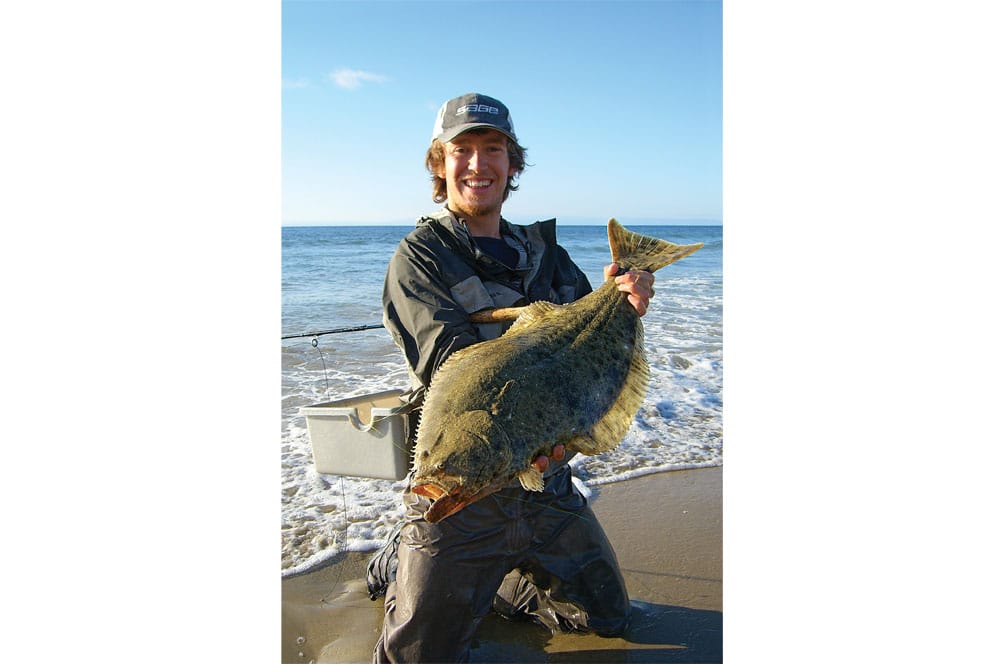

California Halibut
